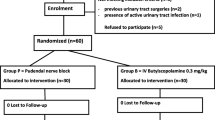Abstract
Background
The reported high incidence of 30–60% postoperative pain after an elective day surgical orchidopexy is undesirable. We evaluated the efficacy of our analgesic regimen for unilateral orchidopexy in preschool children performed as a day surgical procedure.
Methods
Between January 2004 and December 2006, 247 children (mean age: 3.3 ± 1.6 years) underwent a unilateral orchidopexy as a day surgical procedure. They were prospectively analyzed for postoperative pain during a period of 48 h by using the Visual Analogue Scale (VAS). After standardized general anesthesia, all children had a 0.25% levo-bupivacaine hydrochloride ilio-inguinal block and a rectal diclofenac sodium suppository. Orchidopexy was performed through transverse inguinal and scrotal incisions. The wounds were infiltrated with 0.25% levo-bupivacaine hydrochloride at the end of the operation. Postoperatively acetaminophen and ibuprofen were given orally at regular intervals for 48 h.
Results
On first assessment in the recovery room, 148 out of 247 (60%) patients were pain-free, and 99 of 247 (40%) patients had pain: VAS score ranged from 3 to 10. By 3 h, 27 (11%) had mild-to-moderate pain, with VAS scores between 3 and 7. All children were discharged home at 4 h with no pain. At home, 95% were pain-free at 10 h and 97% by 24 h, with a declining pain score. All children were pain-free at 32, 40, and 48 h. Pain scores were unrelated to the duration of surgery (r s = 0.54).
Conclusion
Clinical effectiveness of our institution analgesic regime justifies the performance of unilateral orchidopexy as a day-case procedure.


Similar content being viewed by others
References
Ho D, Keneally JP (2000) Analgesia following paediatric day—surgical orchidopexy and herniotomy. Paediatr Anaesth 10:627–631
Brennan LJ (1999) Modern day-case anaesthesia for children. Br J Anaesth 83:91–103
Tan SGM, May HA, Cunlife M (1994) An audit of pain and vomiting in paediatric day-case surgery. Pediatr Anaesth 4:105–109
Kolinsky E, Thornberg E, Ostlund AL, Larson LE (1999) Postoperative comfort in paediatric outpatient surgery. Paediatr Anaesth 9:243–251
Lim SL, Ng Sb A, Tan GM (2002) Ilioinguinal/iliohypogastric nerve block revisited; single shot versus double shot technique for hernia repair in children. Pediatr Anaesth 12:255–260
Hannallah RS, Broadman LM, Belman AB, Abromowitz MD, Epstein BS (1987) Comparison of the caudal and ilioinguinal/iliohypogastric nerve blocks for control of post-orchidopexy pain in paediatric ambulatory surgery. Anesthesiology 66:832–834
Markham SJ, Tomlinson J, Hain WR (1986) Ilioinguinal nerve block in children. A comparison with caudal block for intra and postoperative analgesia. Anaesthesia 41:1098–1103
Machotta A, Risse A, Berker S, Streich R, Pappert D (2003) Comparison between instillation of bupivacaine versus caudal analgesia for postoperative analgesia following inguinal herniotomy in children. Paediatr Anaesth 13:397–402
Lonnqvist P-A, Morton NS (2005) Postoperative analgesia in infants and children. Br J Anaesth 95:59–68
Kokki H (2003) Nonsteroidal anti-inflammatory drugs for postoperative pain: a focus on children. Paediatric Drugs 5:103–123
Locatelli B, Ingelomo P, Sonzogni V, Zanella A, Gatti V, Spotti A, Di Marco S, Fumagalli R (2005) Randomised double-blind phase III controlled trial comparing levo-bupivacaine 0.25%, reopivacaine 0.25% and bupivacaine 0.25% by the caudal route in children. Br J Anaesth 94:366–371
Samuel M, Hampson-Evans D, Cunningham M (2002) Prospective randomised double blind controlled trial to assess efficacy of double caudal analgesia in hypospadias repair. J Pediatr Surg 37:168–174
Wong DL, Baker CM (1988) Pain in children: comparisons of assessment scales. Pediatr Nurs 14:9–17
Morgan J, Peden V, Bhaskar K, Vater M, Choonara I (2001) Assessment of the pain by parents in young children following surgery. Pediatr Anaesth 11:449–452
Wilson GAM, Doyle E (1996) Validation of three paediatric pain scores for use by parents. Anaesthesiology 51:1005–1007
Author information
Authors and Affiliations
Corresponding author
Additional information
Study registered with the Audit and Effectiveness Department.
Rights and permissions
About this article
Cite this article
Saeed, A., Khan, A.R., Lee, V. et al. Pain Management for Unilateral Orchidopexy in Children: An Effective Regimen. World J Surg 33, 603–606 (2009). https://doi.org/10.1007/s00268-008-9847-7
Published:
Issue Date:
DOI: https://doi.org/10.1007/s00268-008-9847-7




